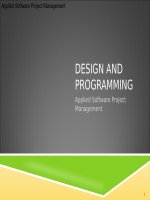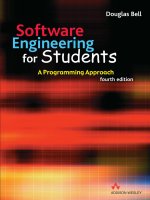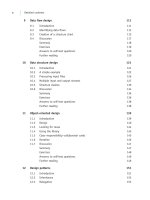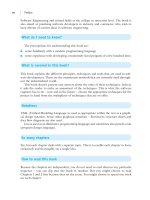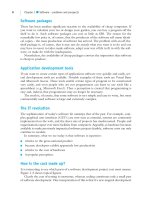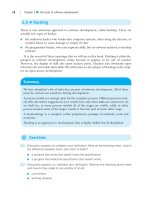engineering graphics, autocad and programming
Bạn đang xem bản rút gọn của tài liệu. Xem và tải ngay bản đầy đủ của tài liệu tại đây (196.84 KB, 22 trang )
Engineering Graphics, AutoCAD
and Programming, CE20
Kurt McMullin, Ph.D., P.E.
San Jose State University
Course Goals from CE Faculty
❧
To introduce the
students to
engineering graphics,
both computer and
manual.
❧
To learn basic skills in
AutoCAD to be used
in upper-division CE
classes.
❧
To gain additional
skills in computer
programming through
the use of Visual Basic
for EXCEL.
❧
To be introduced to
the types of projects
that civil engineers
design and build.
Who we are not?
❧
Not artists. Their
work transfers
emotions.
❧
Not architects. We
will not work with
shading, perspectives,
or texturing.
Who we might be
❧
Drafters. Most times
we produce work for
drafters to perform.
❧
We may be called
upon to draw
production quality
drawings when the
drafting people are
overloaded.
Who we will probably be
❧
Civil Engineers.
❧
Most of our time will
be involved in the
design and the
calculation of
engineering projects.
❧
Usually we will
produce small working
drawings of our result.
❧
As part of the
calculations, we often
will use spreadsheets
(such as EXCEL) that
we might create, or
that another engineer
may have made
before.
Teaching Style
❧
A recent study listed
the methods of
classroom instruction
that Civil Engineering
students prefer.
❧
The list shows the
favorites
❧
Lecture/Discussion/
Problem Solving.
❧
Working in teams,
group interaction.
❧
Visual presentations
by instructor
(Mmedia, video)
❧
Computer
assignments.
And the Losers!
❧
And it also listed those
least preferred.
❧
Homework, especially
ungraded.
❧
Formal “chalkboard”
lecture.
Our Course
❧
Project-based learning = students learn the
material to meet the course objectives by
completing a project that requires use of the
skills learned.
❧
Cooperative learning = students work in
small teams, sharing their knowledge and
learning from their fellow team members.
Drafting Engineer = A
❧
Someone who can produce a wide variety
of drawings with minimal guidance.
❧
Exams and projects show that engineer can
analyze information and make rational
decisions.
Drafter = B
❧
Can produce drawings on a wide variety of
projects but needs assistance in
understanding the layout, orientation,
and/or other pertinent information.
❧
Can choose the appropriate drawing view
for a project.
❧
Can scale and layout drawing.
Tracer = C
❧
Can reproduce the changes marked by
another engineer.
❧
Is unable to evaluate the project and make
decisions about views, scale and/or layout.
Beginner = D
❧
Can use some commands of AutoCAD but
is unable to complete the drawings
assigned.
❧
Shows potential but needs to improve in
productivity.
Unemployed = F
❧
Is not able to contribute to completion of
project.
❧
Is more of a liability than asset.
Professionalism
❧
Does not require close
supervision.
❧
Regards their
supervisor as their
peer, and vice versa.
❧
Takes full
responsibility for their
actions.
❧
Avoids rumors.
❧
Continual self-
improvement.
❧
Loyal to fellow
workers and
employers.
❧
Does not advance at
the expense of others.
❧
Proud of profession.
Extra Credit for CE20
❧
I will allow up to 5% of the course grade for
students to receive extra credit.
❧
This extra credit is awarded for
extracurricular activities where the student
participates.
❧
Credit is received after a paper explaining
the work is written and reviewed.
Rules for Extra Credit
❧
Activity must be related to civil
engineering.
❧
Student must play an active role in the
activity. Officer of a club, attendance at
seminars and/or presentations.
❧
Student is not compensated: credit for
CE105, class field trips, paid internships.
Acceptable Ideas?
❧
A wide variety of activities and/or ideas
will qualify for this extra credit.
❧
Please talk to the instructor about what you
are involved with, how it could be used for
extra credit, and how much extra credit the
activity is worth.
McMullin’s Law of Plotters
❧
Theorem 1
❧
Plotters and printers work 99%
of the time.
Corollary 1
❧
1% of the time,
printers and plotters
don’t work.
❧
This always
occurs before
deadlines.
Corollary 2
❧
Your client’s schedule
is NOT dependent
upon the operation of
your computer, printer
or plotter.
CADBOMB
Therefore:
❧
We must learn to schedule our work so that an
inoperable computer, printer, or plotter will not
cause a crisis.
❧
Keep hardcopies of works-in-progress.
Remember that you may need to substitute the
draft for the final document.
❧
Know of additional facilities for emergency.
Campus computer labs, Kinko’s, CAD Services.
Civil Engineers sometimes work
in less than ideal situations
❧
Civil Engineers often
work in situations
without support
equipment.
❧
Sometimes even with
no power and no
electricity.
❧
Earthquake response,
accident investigation.
❧
We cannot become so
dependent upon
computer facilities that
when we lose them we
can’t continue our
work.
❧
Lives sometime
depend upon our
immediate response to
all types of disasters.


